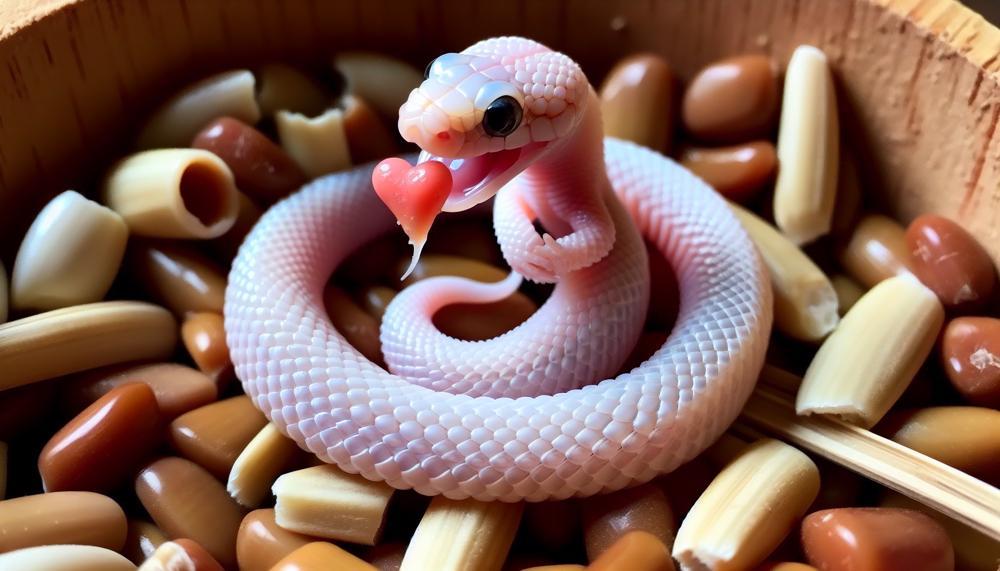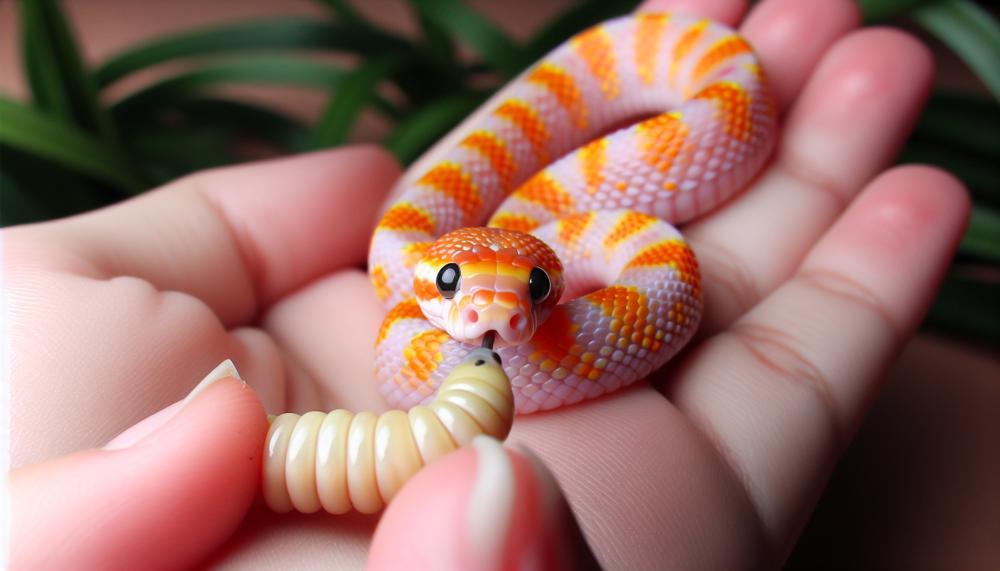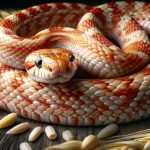Is your little corn snake giving you some major concerns with its lack of appetite?
It’s not uncommon for baby corn snakes to go through periods of not eating.
But if this behavior continues, it could be a red flag for a larger issue.
So, let’s delve into the possible reasons behind your baby corn snake’s reluctance to eat and how you can address them.
From environmental factors to underlying health problems, there are various elements that can affect a snake’s appetite.
We’ll also provide helpful tips on how to entice your little one to eat and when it may be necessary to seek professional assistance.
As a devoted snake parent, it’s crucial to understand the nuances of your pet’s feeding habits and take appropriate action.
So, let’s embark on a journey into the fascinating world of baby corn snakes and their unique eating behaviors.
Contents
Your Snake is Too Cold
Temperature is a critical factor in the appetite and well-being of a young corn snake. As cold-blooded creatures, snakes rely on external heat sources to regulate their body temperature and metabolism. Without proper temperatures, their hunger may decrease, leading to potential health problems.
To ensure your baby corn snake is warm enough to eat, it is crucial to maintain the right temperature range in their enclosure. The ideal basking spot for a young corn snake should be between 85-88°F, with a cooler side of the enclosure at 75-80°F. This temperature gradient allows the snake to adjust its body temperature by moving between warmer and cooler areas as necessary.
One way to provide heat in the enclosure is through heat lamps, which can be controlled with a thermostat for more precise temperature regulation. Another option is using heat mats under a warm hideout covered by substrate. It is essential to monitor temperatures using digital probe thermometers to ensure they stay within the appropriate range.
In addition to heat, UVB lighting can also play a role in a baby corn snake’s appetite and overall well-being. Recent studies have found that UVB lighting can have positive effects on a snake’s mental and physical health, promoting natural hormone rhythms and behavior.
When installing UVB lighting, it is recommended to use a T5 HO fluorescent tube with a UVI of 2.0-3.0 in the basking area.
Offering Food Too Often
It is crucial to follow appropriate feeding guidelines for baby corn snakes and avoid overfeeding, as this can have negative consequences on their health and well-being. The frequency of feeding for these snakes depends on their age, and it is essential to adhere to these guidelines to ensure their optimal health.
Feeding Frequency for Baby Corn Snakes
As mentioned earlier, the frequency of feeding for baby corn snakes varies based on their age. Here are some general guidelines to follow:

- For hatchlings or baby corn snakes (up to 7 months old), one pinky mouse should be fed every five days.
- Some owners may choose to feed their hatchlings up to three times a week, but it is important to monitor their appetite and adjust accordingly.
- Juvenile corn snakes (6-7 months old) should be fed every 7-10 days.
- Adult corn snakes should be fed every 7-10 days or 1-2 prey animals every 2 weeks.
Consequences of Offering Food Too Frequently
Offering food too often can lead to obesity and other health issues in baby corn snakes. It is crucial to remember that they have a slower metabolism compared to other animals and do not require frequent feedings. Overfeeding can result in obesity, which can cause difficulties shedding, organ damage, and a shorter lifespan.
Moreover, offering food too frequently can also affect the snake’s natural behavior and hunting instincts. Corn snakes are opportunistic predators and do not need to eat every day. By offering food too often, they may lose interest in hunting and their natural instincts.
Your Corn Snake is About to Shed
Snakes naturally shed their skin, which can impact their eating habits in various ways. As they prepare for shedding, they may become less active and lose interest in food. This is because their bodies prioritize the shedding process and conserve energy for it. Furthermore, the old skin may cause discomfort, making it difficult for the snake to move and eat.
To ensure your baby corn snake continues to eat during this time, there are a few precautions you can take. Firstly, ensure that your snake’s habitat maintains the proper humidity levels (40-60%) to aid in the shedding process. You can also provide a lukewarm soaking bowl for your snake to help loosen any stuck skin. This will make the shedding process more comfortable for your snake and ensure a healthy shed.
It’s also crucial to continue offering food during shedding, even if your snake shows decreased interest. However, don’t be alarmed if your snake doesn’t eat during this time as it is normal behavior. Wait until they have completed shedding before offering food again, as their appetite should return to normal.
If your baby corn snake experiences an incomplete shed or retains eye caps, it’s essential to address these issues promptly. This could be a sign of underlying health problems or inadequate care, and seeking veterinary attention is recommended.
Prey Pickiness
Seeing your newborn corn snake reject food can be worrying, but it’s important to remember that they can be selective eaters and may not eat after their first shedding. To determine if your snake is being picky with prey, there are several factors to consider:
- Timing: It’s normal for baby corn snakes to not start eating until 1-2 weeks after hatching, when they have their first shed. If your snake refuses food before this time, it may just be adjusting to its new environment.
- Food preferences: Pinkies (hairless newborn mice) are the most common and preferred food for baby corn snakes. However, if your snake consistently refuses pinkies, you can try offering other options like roaches, vegetables, eggs, fish, beef, or pork liver.
- Feeder size: It’s important to offer prey that matches your snake’s midbody thickness and increase the size as they grow. If the prey is too big or small, your snake may reject it.
- Feeding techniques: Using feeding tongs can mimic natural hunting behavior and entice your snake to eat. You can also try scenting the prey with other animal scents to make it more appealing.
- Enclosure conditions: Proper temperature (75-85°F) and humidity (40-50%) in the enclosure can reduce stress and anxiety during eating. Make sure your snake has a comfortable and secure environment.
- Frozen food storage: If you use frozen/thawed prey, store them in the freezer for no longer than 6 months and discard any excessively freezer-burnt prey.
- Live feeding: Only use live prey as a last resort if frozen/thawed prey is refused. Live prey can harm your snake and should only be used under strict supervision.
Remember to monitor your snake’s weight and adjust feeding frequency accordingly to prevent overfeeding and health issues like obesity. If you’re still concerned about your baby corn snake’s eating habits, consult a reptile veterinarian for advice.
Gravidity
Pregnancy, or gravidity, can greatly influence the eating habits of a baby corn snake. During this time, female snakes may experience a decrease in appetite due to the physical toll and energy required for developing and laying eggs. This can result in weight loss and a weakened immune system, making it vital for owners to keep a close eye on their snake’s weight and consult a veterinarian if needed.
In addition, gravidity can also impact the appetite of female corn snakes after they have given birth. The process of laying eggs can be exhausting and may lead to a decrease in appetite for a period of time. It is important to continue monitoring the snake’s weight and providing proper nutrition during this time to ensure a healthy recovery.
Moreover, gravidity can indirectly affect the appetite of baby corn snakes as well. Female corn snakes often stop eating during pregnancy, resulting in less food available for the hatchlings once they are born. This can create competition among siblings for food and potentially hinder their growth rate.
Your Snake is Ill
Illnesses are a common concern for baby corn snakes and can cause them to stop eating.
These illnesses include respiratory infections, mouth rot, and parasites. If not treated, these diseases can lead to weight loss, lethargy, and other symptoms such as mouth sores.
To prevent these illnesses, it is essential to maintain a clean and spacious enclosure, feed the snake a nutritious diet, and schedule regular check-ups with a veterinarian.
Treatment options for sick snakes may include prescribed medication from a vet or over-the-counter remedies.
Infections usually result from unhygienic conditions or injuries, making proper care and hygiene crucial in keeping your corn snake healthy.
| Illness | Symptoms | Treatment |
|---|---|---|
| Respiratory Infections | Lethargy, loss of appetite, weight loss | Prescribed medication from a vet |
| Mouth Rot | Lethargy, loss of appetite, mouth sores | Prescribed medication from a vet and cleaning with diluted antiseptic solution |
| Parasites | Lethargy, loss of appetite, weight loss | Over-the-counter remedies or prescribed medication from a vet |
Respiratory infections are typically caused by bacteria or viruses and can be contracted through poor sanitation or exposure to other sick snakes. Symptoms may include lethargy, loss of appetite, and weight loss. If left untreated, respiratory infections can worsen and lead to pneumonia. Treatment for respiratory infections may include prescribed antibiotics.
Mouth rot is a bacterial infection that affects the mouth and gums of snakes. It is often the result of injuries to the mouth from sharp objects in the enclosure. Symptoms may include lethargy, loss of appetite, and the presence of mouth sores. To treat mouth rot, a vet may prescribe antibiotics and recommend cleaning the snake’s mouth with a diluted antiseptic solution.
Parasites are another common cause of illness in snakes. These can include mites, ticks, and intestinal worms. Symptoms may include lethargy, loss of appetite, and weight loss. A vet may prescribe medication to treat the specific type of parasite or recommend over-the-counter remedies. Regularly cleaning the snake’s enclosure and bedding can help prevent parasites from infesting the snake.
Other Causes
While the aforementioned factors are common causes of a baby corn snake not eating, there are also lesser-known reasons that can contribute to this behavior. These include temperature and humidity levels, stress and anxiety, shedding, illness or parasites, feeding schedule and prey preferences, and hibernation.
Let’s take a closer look at each of these factors in detail.
| Cause | Description |
| Temperature and Humidity Levels | The ideal temperature range for a baby corn snake is between 75-85 degrees Fahrenheit with a humidity level of 40-50%. If the environment is too hot or too cold, it can affect their appetite and digestion. |
| Stress and Anxiety | Baby corn snakes can experience stress and anxiety from changes in their environment or loud noises. Providing a calm and peaceful space for them is crucial to ensure they feel safe and comfortable. |
| Shedding | During the shedding process, snakes may experience discomfort or irritation, leading to a loss of appetite. This behavior is normal, but if it persists or your snake struggles with shedding, it is advisable to consult a veterinarian. |
| Illness or Parasites | If your baby corn snake falls ill from respiratory infections, mouth rot, or parasites, they may lose their appetite due to pain and discomfort. Regular health checks and proper hygiene can help prevent these issues. |
| Feeding Schedule and Prey Preferences | Baby corn snakes can be picky eaters, so offering a variety of prey options on a regular schedule is crucial to ensure they receive proper nutrition. |
| Hibernation | Some baby corn snakes may exhibit a decreased appetite during the winter months, but this is a normal behavior. It is important to continue offering food regularly and monitor their weight to ensure they maintain a healthy size. |
Also Read: Why Is My Corn Snake Shedding Too Often?
Conclusion
In conclusion, it can be worrisome when your baby corn snake refuses to eat, but rest assured that this is a common behavior.
However, if it continues for an extended period of time, it may indicate a larger underlying issue. A variety of factors, such as environmental conditions and health problems, can contribute to your snake’s lack of appetite.
As dedicated snake parents, it is our responsibility to closely monitor our pets’ feeding habits and take appropriate action when needed.






